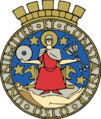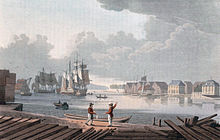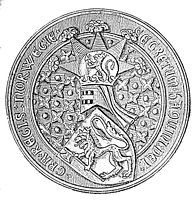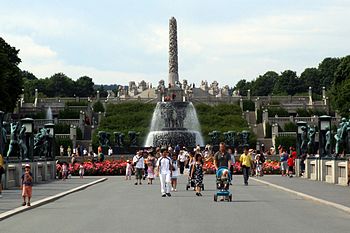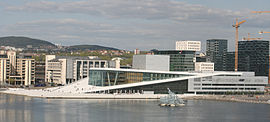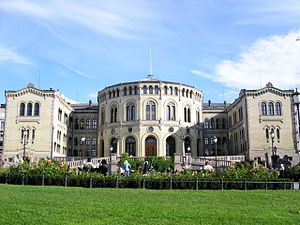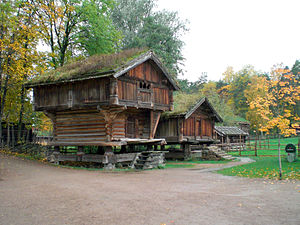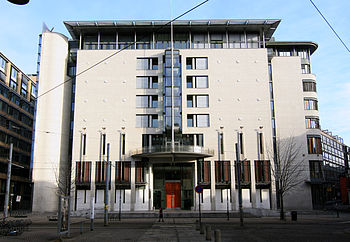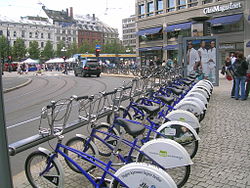
Oslo
Did you know...
This Wikipedia selection is available offline from SOS Children for distribution in the developing world. SOS Children works in 45 African countries; can you help a child in Africa?
| Oslo | |||
|---|---|---|---|
 |
|||
|
|||
| Motto: Unanimiter et constanter (Latin: United and constant) |
|||
|
|
|||
| Coordinates: 59°56′58″N 10°45′23″E Coordinates: 59°56′58″N 10°45′23″E | |||
| Country | Norway | ||
| District | Østlandet | ||
| County | Oslo | ||
| Municipality | |||
| Established | 1048 | ||
| Government | |||
| • Mayor | Fabian Stang ( H) | ||
| • Governing mayor | Stian Berger Røsland ( H) | ||
| Area | |||
| • City | 454.03 km2 (175.30 sq mi) | ||
| • Urban | 289.84 km2 (111.91 sq mi) | ||
| • Metro | 8,900 km2 (3,400 sq mi) | ||
| Population (Jan. 2013) | |||
| • City | 623,966 | ||
| • Density | 1,400/km2 (3,600/sq mi) | ||
| • Urban | 951,581 | ||
| • Urban density | 3,300/km2 (8,500/sq mi) | ||
| • Metro | 1,442,318 | ||
| • Metro density | 160/km2 (420/sq mi) | ||
| Ethnic groups | |||
| • Norwegians | 71.5% | ||
| • Pakistanis | 3.6% | ||
| • Swedes | 2.2% | ||
| • Somalis | 2.0% | ||
| • Poles | 1.7% | ||
| Time zone | CET ( UTC+1) | ||
| • Summer ( DST) | CEST ( UTC+2) | ||
| Website | www.oslo.kommune.no | ||
| Oslo kommune | |||
|---|---|---|---|
| — Municipality — | |||
|
|||
| Oslo within Oslo | |||
| Country | Norway | ||
| County | Oslo | ||
| Time zone | CET ( UTC+1) | ||
| • Summer ( DST) | CEST ( UTC+2) | ||
| ISO 3166 code | NO-0301 | ||
| Official language form | |||
|
|
|||
Oslo (English pronunciation: / ˈ ɒ z l oʊ /, OZ-loh, Norwegian pronunciation: [²uʃlu] or, rarer [²uslu] or [1uʃlu]) is the capital of and most populous city in Norway. Founded around 1048 by King Harald III, the city was elevated to a bishopric in 1070 and a capital under Haakon V around 1300. Personal unions with Denmark from 1397 to 1523 and again from 1536 to 1814 and with Sweden from 1814 to 1905 reduced its influence. After being destroyed by a fire in 1624, the city was moved closer to Akershus Castle during the reign of King Christian IV and renamed Christiania in his honour. It was established as a municipality ( formannskapsdistrikt) on 1 January 1838. Following a spelling reform, it was known as Kristiania from 1877 to 1925, when its original Norwegian name was restored.
Oslo is the economic and governmental centre of Norway. The city is also a hub of Norwegian trade, banking, industry and shipping. It is an important centre for maritime industries and maritime trade in Europe. The city is home to many companies within the maritime sector, some of which are among the world's largest shipping companies, shipbrokers and maritime insurance brokers. Oslo is a pilot city of the Council of Europe and the European Commission intercultural cities programme.
Oslo is considered a global city and ranked "Beta World City" in studies performed by the Globalization and World Cities Study Group and Network in 2008. It was ranked number one in terms of quality of life among European large cities in the European Cities of the Future 2012 report by fDi Magazine. For several years, Oslo has been listed as one of the most expensive cities in the world along with such other global cities as Zurich, Geneva, Copenhagen, Paris, and Tokyo. In 2009, however, Oslo regained its status as the world's most expensive city. A survey conducted by ECA International in 2011 placed Oslo 2nd after Tokyo.
As of 2010 the metropolitan area of Oslo has a population of 1,442,318, of whom 912,046 live in the contiguous conurbation. The population currently increases at record rates, making it the fastest growing city in Europe. This growth stems for the most part from immigration and high birth rates among immigrants, but also from intra-national migration. The Norwegian population in the city is not decreasing in absolute numbers, but in relative terms the percentage of native Norwegians of the total population in the city proper is decreasing due to a growing immigrant population and thus a growing total population. The immigrant share of the population in the city proper now counts more than 25% of the city's total.
Urban region
As of January 2013, the population of the municipality of Oslo in excess of 623,000. The urban area extends beyond the boundaries of the municipality into the surrounding county of Akershus, (municipalities of Bærum, Asker, Røyken, Lørenskog, Skedsmo, Gjerdrum, Sørum, Oppegård) its agglomeration total 951,581 inhabitants. The metropolitan area of Oslo, also referred to as the Greater Oslo Region ( Norwegian: Stor-Osloregionen), has a land area of 8,900 km2 (3,400 sq mi) with a population of 1,422,442 as of 1 April 2010. The Inner Oslo Fjord Region, or the Capital Region made up by the five counties of Oslo, Akershus, Buskerud, Vestfold (west bank of the Oslo fjord) and Østfold (east bank) has a population of 1,980,116 people (as of January 2013). The city centre is situated at the end of the Oslofjord, from which point the city sprawls out in three distinct "corridors" from its centre; inland north-eastwards, and southwards along both sides of the fjord, which gives the urbanized area a shape reminiscent of an upside-down reclining "Y" (on maps, satellite pictures, or from high above the city).
To the north and east, wide forested hills (Marka) rise above the city giving the location the shape of a giant amphitheatre. The urban municipality (bykommune) of Oslo and county of Oslo (fylke) are two parts of the same entity, making Oslo the only city in Norway where two administrative levels are integrated. Of Oslo's total area, 115 km2 (44 sq mi) is built-up and 7 km2 (2.7 sq mi) is agricultural. The open areas within the built-up zone amount to 22 km2 (8.5 sq mi).
The city of Oslo was established as a municipality on 3 January 1838 (see formannskapsdistrikt). It was separated from the county of Akershus to become a county of its own in 1842. The rural municipality of Aker was merged with Oslo on 1 January 1948 (and simultaneously transferred from Akershus county to Oslo county). Furthermore, Oslo shares several important functions with Akershus county. The neighbouring industrial commune of Aker was incorporated into Oslo in 1948. the population after that went down fast at about 531,124.
General information
Toponymy
The origin of the name Oslo has been the subject of much debate. It is certainly derived from Old Norse and was—in all probability—originally the name of a large farm at Bjørvika, but the meaning of that name is disputed. Modern linguists generally interpret the original Óslo or Áslo as either "Meadow at the Foot of a Hill" or "Meadow Consecrated to the Gods", with both considered equally likely.
Erroneously, it was once assumed that "Oslo" meant "the mouth of the Lo river", a supposed previous name for the river Alna. However, not only has no evidence been found of a river "Lo" predating the work where Peder Claussøn Friis first proposed this etymology, but the very name is ungrammatical in Norwegian: the correct form would have been Loaros (cf. Nidaros). The name Lo is now believed to be a back-formation arrived at by Friis in support of his spurious etymology for Oslo.
City seal
Oslo is one of very few cities in Norway, besides Bergen and Tønsberg, that does not have a formal coat of arms, but which uses a city seal instead. The seal of Oslo shows the city's patron saint, St. Hallvard, with his attributes, the millstone and arrows, with a naked woman at his feet. He is seated on a throne with lion decorations, which at the time was also commonly used by the Norwegian Kings.
History
| Oslo Timeline (major events) | |
|---|---|
| CA. 1000 AD | First traces of buildings. The St. Clement's Church is built. |
| CA. 1050 AD | Oslo marked as a city. Mariakirken is built. |
| 1152/53 AD | The Cathedral school is established |
| 1299 AD | Oslo becomes the capital of Norway |
| CA. 1300 | Construction of Akershus Fortress starts. |
| 1350 AD | Around 3/4 of the population dies under the Black Death. |
| 1352 AD | St. Hallvard's Cathedral and the other Sogne Churches are burned to the ground in a major fire |
| 1624 AD | Another major fire, the city is rebuilt and renamed Christiania by Christian 4. |
| 1686 AD | Fire ruins 1/4 of the city. |
| 1697 AD | Domkirken is finished and opened |
| 1716 AD | The city and the fortress conquered by Karl 12. |
| 1813 | The University is opened. |
| 1825 | The foundations of Slottet are finished. |
| 1836 | The National Gallery is finished. |
| 1837 | Christiania Theatre is opened. Christiania and Aker get a Mayor and kommunestyre. |
| 1854 | Oslo gets its first railway, which leads to Eidsvoll. |
| 1866 | Stortinget is completed. |
| 1878 | City expanded. Frogner, Majorstuen, Torshov, Kampen and Vålerengen are populated and rebuilt. 113000 citizens. |
| 1892 | The first Holmenkollbakken is finished. |
| 1894 | The city gets its first electrical track. |
| 1899 | Nationaltheateret is finished. |
| 1925 | City renamed as Oslo. |
| 1927 | The Monolith is raised. |
| 1928 | Oslo first Metro line, Majorstuen-Besserud is opened. |
| 1950 | Oslo City Hall opened. |
| 1963 | The Munch Museum is opened. |
| 1980 | Metro line under the city, Oslo Central Station and Nationaltheatret Station opened. |
| 1997 | Population over 500 000. |
| 1998 | Rikshospitalet opened. New railway line to Gardermoen. |
| 2000 | The city celebrates thousand-years jubilee. |
| 2008 | Oslo Opera House is opened. |
| 2011 | Several buildings in the Regjeringskvartalet are heavily damaged during a terrorist attack, resulting in 8 deaths. 69 people are massacred on the nearby Utøya island. |
According to the Norse sagas, Oslo was founded around 1049 by King Harald Hardråde. Recent archaeological research has uncovered Christian burials which can be dated to prior to AD 1000, evidence of a preceding urban settlement. This called for the celebration of Oslo's millennium in 2000.
It has been regarded as the capital city since the reign of King Haakon V (1299–1319), the first king to reside permanently in the city. He also started the construction of the Akershus Castle. A century later, Norway was the weaker part in a personal union with Denmark, and Oslo's role was reduced to that of provincial administrative centre, with the monarchs residing in Copenhagen. The fact that the University of Oslo was founded as late as 1811 had an adverse effect on the development of the nation.
Oslo was destroyed several times by fire, and after the fourteenth calamity, in 1624, King Christian IV of Denmark and Norway ordered it rebuilt at a new site across the bay, near Akershus Castle and given the name Christiania. Long before this, Christiania had started to establish its stature as a centre of commerce and culture in Norway. The part of the city built starting in 1624 is now often called Kvadraturen because of its orthogonal layout. The last plague outbreak ravaged Oslo in 1654. In 1814 Christiania once more became a real capital when the union with Denmark was dissolved.
Many landmarks were built in the 19th century, including the Royal Palace (1825–1848); Stortinget (the Parliament) (1861–1866), the University, Nationaltheatret and the Stock Exchange. Among the world-famous artists who lived here during this period were Henrik Ibsen and Knut Hamsun (the latter was awarded the Nobel Prize for literature). In 1850, Christiania also overtook Bergen and became the most populous city in the country. In 1877 the city was renamed Kristiania. The original name of Oslo was restored in 1925.
1000–1600
Under the reign of King Olav Kyrre, Oslo became a cultural centre for Eastern Norway. St. Hallvard became the city's patron saint and is depicted on the city's seal.
In 1174, Hovedøya Abbey (Hovedøya kloster) was built. The churches and abbeys became major owners of large tracts of land, which proved important for the city's economic development, especially before the Black Death.
During the Middle Ages, Oslo reached its heights in the reign of King Haakon V. He started the building of Akershus Castle and was also the first king to reside permanently in the city, which helped to make Oslo the capital of Norway.
In the end of the 12th century, Hanseatic traders from Rostock moved into the city and gained major influence in the city. The Black Death came to Norway in 1349 and, like other cities in Europe, the city suffered greatly. The churches' earnings from their land also dropped so much that the Hanseatic traders dominated the city's foreign trade in the 15th century.
1600s
Over the years, fire destroyed major parts of the city many times, as many of the city's buildings were built entirely of wood. After the last fire in 1624, which lasted for three days, King Christian IV decided that the old city should not be rebuilt again. His men built a network of roads in Akershagen near Akershus Castle. He demanded that all citizens should move their shops and workplaces to the newly built city of Christiania.
The transformation of the city went slowly for the first hundred years. Outside the city, near Vaterland and Grønland near Old Town, Oslo, a new, unmanaged part of the city grew up with citizens of low status.
1700s
In the 18th century, after the Great Northern War, the city's economy boomed with shipbuilding and trade. The strong economy transformed Christiania into a trading port.
1800s
In the 19th century, several state institutions were established and the city's role as a capital intensified. Christiania expanded its industry from 1840, most importantly around Akerselva. The expansion prompted the authorities to construct several important buildings, most of which remain as tourist attractions. There was a brief building boom from 1880, with many new houses, but the boom collapsed in 1889.
1900–present
Auctioning off of children was prohibited by law ( Fattigloven) in 1900, as a result of court cases related to children having died/been killed.
The municipality developed new areas such as Ullevål Hageby (1918–1926) and Torshov (1917–1925). City Hall was constructed in the former slum area of Vika, from 1931–1950. The municipality of Aker was incorporated into Oslo in 1948, and suburbs were developed, such as Lambertseter (from 1951). Aker Brygge was constructed on the site of the former shipyard Akers Mekaniske Verksted, from 1982–1998.
On 22 July 2011, Oslo was hit by a bomb blast that ripped through the city central government district, also damaging Prime Minister Jens Stoltenberg's office while he was absent and the nearby Ministry of Petroleum. The terrorist blast killed eight people prior to a shooting spree on the island of Utøya on lake Tyrifjorden, which killed 69 youths participating in a Norwegian Labour Party youth camp. The culprit is Anders Behring Breivik.
-
The seal of Haakon V Magnusson, the King who made Oslo the capital of Norway
Geography
Oslo occupies an arc of land at the northernmost end of the Oslofjord. The fjord, which is nearly bisected by the Nesodden peninsula opposite Oslo, lies to the south; in all other directions Oslo is surrounded by green hills and mountains. There are 40 islands within the city limits, the largest being Malmøya (0.56 km2/0.22 sq mi), and scores more around the Oslofjord. Oslo has 343 lakes, the largest being Maridalsvannet (3.91 km2/1.51 sq mi). This is also a main source of drinking water for large parts of Oslo.
Although Eastern Norway has a number of rivers, none of these flow into the ocean at Oslo. Instead Oslo has two smaller rivers: Akerselva (draining Maridalsvannet, which flows into the fjord in Bjørvika), and Alna. The waterfalls in Akerselva gave power to the first modern industry of Norway in the 1840, and later in the century, the river became the symbol of the stable and consistent economic and social divide of the city into an East End and a West End; the labourers' neighbourhoods lie on both sides of the river, and the divide in reality follows Uelands street a bit further west. River Alna flows through Groruddalen, Oslo's major suburb and industrial area. The highest point is Kirkeberget, at 629 metres (2,064 ft). Although the city's population is small compared to most European capitals, it occupies an unusually large land area, of which two thirds are protected areas of forests, hills and lakes. Its boundaries encompass many parks and open areas, giving it an airy and green appearance.
Climate
Oslo has a humid continental climate (Dfb according to the Köppen climate classification system). Because of the city's northern latitude, daylight varies greatly, from more than 18 hours in midsummer, when it never gets completely dark at night, to around 6 hours in midwinter. Despite its high latitude and northerly location, the climate is not severely cold due to the onshore airmasses in winter and the coastal location of the city.
Oslo has cool summers with average high temperatures of around 19–22 °C (66–72 °F) and lows of around 12 °C (54 °F). The highest temperature ever recorded was 35 °C (95 °F) on 21 July 1901. Winters are cold and snowy with temperatures between −7 °C (19 °F) up to −1 °C (30 °F). The coldest temperature recorded is −27.1 °C (−16.8 °F) in January 1942. Temperatures have tended to be higher in recent years.
Annual precipitation is 763 millimetres (30.0 in) with moderate rainfall throughout the year. Snowfall can occur from November to April, but snow accumulation occurs mainly from January through March. Almost every winter, ice develops in the innermost parts of the Oslofjord, and during some winters the whole inner fjord freezes. As it is far from the mild Atlantic water of the west coast, this large fjord can freeze over completely, although this has become rare. Oslo receives around 1,650 hours of sunshine annually and is average for the northern half of Europe.
| Climate data for Oslo, Norway | |||||||||||||
|---|---|---|---|---|---|---|---|---|---|---|---|---|---|
| Month | Jan | Feb | Mar | Apr | May | Jun | Jul | Aug | Sep | Oct | Nov | Dec | Year |
| Record high °C (°F) | 13 (55) |
15 (59) |
22 (71) |
26 (79) |
30 (86) |
34 (93) |
35 (95) |
34 (94) |
27 (81) |
23 (74) |
14 (58) |
13 (55) |
35 (95) |
| Average high °C (°F) | 1 (34) |
2 (36) |
6 (43) |
9 (48) |
16 (61) |
20 (68) |
22 (72) |
20 (68) |
16 (61) |
10 (50) |
4 (39) |
−1 (30) |
10.4 (50.8) |
| Average low °C (°F) | −7 (19) |
−7 (19) |
−3 (27) |
1 (34) |
7 (45) |
11 (52) |
13 (55) |
12 (54) |
7 (45) |
4 (39) |
−1 (30) |
−5 (23) |
2.7 (36.8) |
| Record low °C (°F) | −26 (−15) |
−25 (−13) |
−21 (−6) |
−16 (3) |
−4 (24) |
1 (33) |
4 (39) |
2 (36) |
−4 (25) |
−11 (12) |
−16 (3) |
−24 (−11) |
−26 (−15) |
| Precipitation mm (inches) | 49 (1.93) |
36 (1.42) |
47 (1.85) |
41 (1.61) |
53 (2.09) |
65 (2.56) |
81 (3.19) |
89 (3.5) |
90 (3.54) |
84 (3.31) |
73 (2.87) |
55 (2.17) |
763 (30.04) |
| Snowfall cm (inches) | 14.1 (5.55) |
21.8 (8.58) |
21.4 (8.43) |
3.5 (1.38) |
0 (0) |
0 (0) |
0 (0) |
0 (0) |
0 (0) |
0.4 (0.16) |
4.3 (1.69) |
11.7 (4.61) |
77.2 (30.39) |
| Avg. rainy days | 3 | 3 | 7 | 11 | 10 | 13 | 15 | 14 | 14 | 14 | 5 | 3 | 112 |
| Avg. snowy days | 12 | 9 | 3 | 1 | 0 | 0 | 0 | 0 | 0 | 1 | 12 | 15 | 53 |
| Mean monthly sunshine hours | 40 | 76 | 126 | 178 | 220 | 250 | 246 | 216 | 144 | 86 | 51 | 35 | 1,668 |
| Source #1: Minifakta om Norge (SSB) | |||||||||||||
| Source #2: The Weather Network | |||||||||||||
Parks and recreation areas
Oslo has a large number of parks and green areas within the city core, as well as outside it.
- Frogner Park is a large park located a few minutes walk away from the city centre. This is the biggest and most reputed park in Norway with a large collection of sculptures of Gustav Vigeland
- Bygdøy is a huge and green area, commonly called the Museum Peninsula of Oslo. The beautiful location, surrounded by the sea, makes it the most expensive Norwegian district.
- St. Hanshaugen Park is an old public park on a high hill in central Oslo. 'St. Hanshaugen' is also the name of the surrounding neighbourhood as well as the larger administrative district (borough) that includes major parts of central Oslo.
- Tøyen Park stretches out behind the Munch Museum, and is a vast, grassy expanse. In the north, there is a viewing point known as Ola Narr. The Tøyen area also includes the Botanical Garden and Museum belonging to the University of Oslo.
Oslo (with neighbouring Sandvika-Asker) is built in a horseshoe shape on the shores of the Oslofjord and limited in most directions by hills and forests. As a result, any point within the city is relatively close to the forest. There are two major forests bordering the city: Østmarka (literally "Eastern Forest", on the eastern perimeter of the city), and the very large Nordmarka (literally "Northern Forest", stretching from the northern perimeter of the city deep into the hinterland).
The municipality operates eight public swimming pools. Tøyenbadet is the largest indoor swimming facility in Oslo and one of the few pools in Norway offering a 50-metre main pool. The outdoor pool Frognerbadet also has the 50-metre range.
Cityscape
Oslo's cityscape is being redeveloped as a modern city with various access-points, an extensive metro-system with a new financial district and a cultural city. In 2008, an exhibition was held in London presenting the award-winning Oslo Opera House, the urban regeneration scheme of Oslo's seafront, Munch/Stenersen and the new Deichman Library. Most of the buildings in the city and in neighbouring communities are low in height with only the Plaza, Postgirobygget and the highrises at Bjørvika considerably taller.
Architecture
Oslo's architecture is very diverse. The architect Carl Frederik Stanley (1769–1805), who was educated in Copenhagen, spent some years in Norway around the turn of the 19th century. He did minor works for wealthy patrons in and around Oslo, but his major achievement was the renovation of the Oslo Katedralskole, completed in 1800. He added a classical portico to the front of an older structure, and a semicircular auditorium that was sequestered by Parliament in 1814 as a temporary place to assemble, now preserved at Norsk Folkemuseum as a national monument.
When Christiania was made capital of Norway in 1814, there were practically no buildings suitable for the many new government institutions. An ambitious building program was initiated, but realised very slowly because of economic constraints. The first major undertaking was the Royal Palace, designed by Hans Linstow and built between 1824 and 1848. Linstow also planned Karl Johans gate, the avenue connecting the Palace and the city, with a monumental square halfway to be surrounded by buildings for University, the Parliament (Storting) and other institutions. Only the university buildings were realised according to this plan. Christian Heinrich Grosch, one of the first architects educated completely within Norway, designed the original building for the Oslo Stock Exchange (1826–1828), the local branch of the Bank of Norway (1828), Christiania Theatre (1836–1837), and the first campus for the University of Oslo (1841–1856). For the university buildings, he sought the assistance of the renowned German architect Karl Friedrich Schinkel.} German architectural influence persisted in Norway, and many wooden buildings followed the principles of Neoclassicism. In Oslo, the German architect Alexis de Chateauneuf designed Trefoldighetskirken, the first neo-gothic church, completed by von Hanno in 1858.
A number of landmark buildings, particularly in Oslo, were built in the Functionalist style (better known in the US and Britain as Modernist), the first being Skansen restaurant (1925–1927) by Lars Backer, demolished in 1970. Backer also designed the restaurant at Ekeberg, which opened in 1929. Kunstnernes Hus art gallery by Gudolf Blakstad and Herman Munthe-Kaas (1930) still shows the influence of the preceding classicist trend of the 1920s. The redevelopment of Oslo Airport (by the Aviaplan consortium) at Gardermoen, which opened in 1998, was Norway's largest construction project to date.
-
Oslo Suburbs
-
Jernbanetorget
-
Industrial building at Akerselva
Politics and government
Oslo is the capital of Norway, and as such is the seat of Norway's national government. Most government offices, including that of the Prime Minister, are gathered at Regjeringskvartalet, a cluster of buildings close to the national Parliament—the Storting.
Constituting both a municipality and a county of Norway, the city of Oslo is represented in the Storting by seventeen Members of Parliament. Six MPs are from the Labour Party; the Conservative Party and the Progress Party have three each; the Socialist Left Party and the Liberals have two each; and one is from the Christian Democrats.
The combined municipality and county of Oslo has had a parliamentary system of government since 1986. The supreme authority of the city is the City Council (Bystyret), which currently has 59 seats. Representatives are popularly elected every four years. The City Council has five standing committees, each having its own areas of responsibility. The largest parties in the City Council after the 2011-elections are the Conservatives and the Labour Party, with 22 and 20 representatives respectively.
The Mayor of Oslo is the head of the City Council and the highest ranking representative of the city. This used to be the most powerful political position in Oslo, but following the implementation of parliamentarism, the Mayor has had more of a ceremonial role, similar to that of the President of the Storting at the national level. The current Mayor of Oslo is Fabian Stang.
Since the local elections of 2003, the city government has been a coalition of the Conservative Party and the Progress Party. Based mostly on support from the Christian Democrats and the Liberals, the coalition maintains a workable majority in the City Council. After the 2007 local elections on 10 September, the conservative coalition remained in majority. After the elections in 2011 the Conservative Party remained in power after a strong election. The Progress Party chose to leave the city government after losing support in the election and a dispute over the new Munch Museum. The Liberals and the Christian Democrats replaced the Progress Party in the city government.
The Governing Mayor of Oslo is the head of the City government. The post was created with the implementation of parliamentarism in Oslo and is similar to the role of the prime minister at the national level. The current governing mayor is Stian Berger Røsland.
Economy
Oslo has a varied and strong economy and was ranked number one among European large cities in economic potential in the fDi Magazine report European Cities of the Future 2012. It was ranked 2nd in the category of business friendliness, behind Amsterdam.
Oslo is an important centre of maritime knowledge in Europe and is home to approximately 1980 companies and 8,500 employees within the maritime sector, some of which are the world's largest shipping companies, shipbrokers, and insurance brokers. Det Norske Veritas, headquartered at Høvik outside Oslo, is one of the three major maritime classification societies in the world, with 16.5% of the world fleet to class in its register. The city's port is the largest general cargo port in the country and its leading passenger gateway. Close to 6,000 ships dock at the Port of Oslo annually with a total of 6 million tonnes of cargo and over five million passengers. The gross domestic product of Oslo totalled NOK268.047 billion ( billion) in 2003, which amounted to 17% of the national GDP. This compares with NOK165.915 billion ( billion) in 1995. The metropolitan area, bar Moss and Drammen, contributed 25% of the national GDP in 2003 and was also responsible for more than one quarter of tax revenues. In comparison, total tax revenues from the oil and gas industry on the Norwegian Continental Shelf amounted to about 16%.
Oslo is one of the most expensive cities in the world. As of 2006, it is ranked tenth according to the Worldwide Cost of Living Survey provided by Mercer Human Resource Consulting and first according to the Economist Intelligence Unit. The reason for this discrepancy is that the EIU omits certain factors from its final index calculation, most notably housing. Although Oslo does have the most expensive housing market in Norway, it is comparably cheaper than other cities on the list in that regard. Meanwhile, prices on goods and services remain some of the highest of any city. Oslo hosts 2654 of the largest companies in Norway. Within the ranking of Europe's largest cities ordered by their number of companies Oslo is in fifth position. A whole group of oil and gas companies is situated in Oslo. According to a report compiled by Swiss bank UBS in the month of August 2006, Oslo and London were the world's most expensive cities.
Environment
Oslo is a compact city. It is easy to move around by public transportation and you can access rentable city bikes all over the city centre. In 2003, Oslo received The European Sustainable City Award and in 2007 Reader's Digest ranked Oslo as number two on a list of the world's greenest, most liveable cities.
Education
Institutions of higher education
- University of Oslo (Universitetet i Oslo (UiO))— undergraduate, graduate and PhD programs in most fields.
- Oslo and Akershus University College of applied sciences (Høgskolen i Oslo og Akershus (HiOA)), former Oslo University College. Focuses on 3–4 year professional degree programs.
- BI Norwegian Business School (Handelshøyskolen BI)—primarily economics and business administration.
- Norwegian School of Information Technology (Norges Informasjonsteknologiske Høyskole (NITH))
- Oslo School of Architecture and Design (Arkitektur- og designhøgskolen i Oslo (AHO))
- Norwegian School of Sport Sciences (Norges idrettshøgskole (NIH))—offers opportunities to study at the Bachelor, Masters and Doctoral level
- Norwegian Academy of Music (Norges musikkhøgskole)
- MF Norwegian School of Theology (Det teologiske Menighetsfakultet - MF)
- Oslo National Academy of the Arts (Kunsthøgskolen i Oslo - KHIO)
- Norwegian University of Life Sciences (Universitetet for Miljø og Biovitenskap - UMB) located in Ås, right outside of Oslo
- Norwegian Army Academy (Krigsskolen)
- The Norwegian Defence University College (Forsvarets høgskole)
- The Norwegian Police University College (Politihøgskolen - PHS)
- Norwegian School of Veterinary Science (Norges Veterinærhøgskole)
- Oslo Academy of Fine Arts (Statens kunstakademi)
- Oslo School of Management (Markedshøyskolen - MH) located at the Campus Kristiania education centre.
The level of education and productivity in the workforce is high in Norway. Nearly half of those with education at tertiary level in Norway live in the Oslo region, placing it among Europe's top three regions in relation to education. In 2008, the total workforce in the greater Oslo region (5 counties) numbered 1,020,000 people. The greater Oslo region has several higher educational institutions and is home to more than 73,000 students. The University of Oslo is the largest institution for higher education in Norway with 27,400 students and 7,028 employees in total.
Culture
Oslo has a large and varied number of cultural attractions, which include several buildings containing artwork from Edvard Munch and various other international artists but also several Norwegian artists. Several world-famous writers have either lived or been born in Oslo. Examples are Knut Hamsun and Henrik Ibsen. The government has recently invested large amounts of money in cultural installations, facilities, buildings and festivals in the City of Oslo. Bygdøy, outside the city centre is the centre for history and the Norwegian Vikings' history. The area contains a large amount of parks and seasites and a large amount of museums. Examples are the Fram Museum, Vikingskiphuset and the Kon-Tiki Museum. Oslo hosts the annual Oslo Freedom Forum, a conference described by The Economist as “on its way to becoming a human-rights equivalent of the Davos economic forum.” Oslo is also known for giving out the Nobel Peace Prize every year.
Museums, galleries
Oslo houses several major museums and galleries. The Munch Museum contains the Scream and other works by Edvard Munch, who donated all his work to the city after his death. The City-Council is currently planning a new Munch Museum which is most likely to be built in Bjørvika, in the southeast of the city. The museum will be named Munch/Stenersen. 50 different museums are located around the city. Folkemuseet is located on the Bygdøy peninsula and is dedicated to Folk art, Folk Dress, Sami culture and the viking culture. The outdoor museum contains 155 authentic old buildings from all parts of Norway, including a Stave Church. The Vigeland Museum located in the large Vigeland Park by many people known as the Frognerpark is free to access and contains over 212 sculptures by Gustav Vigeland including an obelisk and the Wheel of Life. Another popular sculpture is Sinnataggen, a baby boy stamping his foot in fury. This statue is very well known as an icon in the city. The Viking Ship Museum features three Viking ships found at Oseberg, Gokstad and Tune and several other unique items from the Viking age. The Oslo City Museum holds a permanent exhibition about the people in Oslo and the history of the city. The Kon-Tiki Museum houses Thor Heyerdahl's Kontiki and Ra2.
The National Museum holds and preserves, exhibits and promotes public knowledge about Norway's most extensive collection of art. The Museum shows permanent exhibitions of works from its own collections but also temporary exhibitions that incorporate work loaned from elsewhere. The National Museums exhibition avenues are the National Gallery, the Museum of Contemporary Art, the National Museum, the Museum of Decorative Arts and the National Museum of Architecture. A new National Museum in Oslo will be built in the next 10 years. The winner was Forum Artis, and the building will be located at Vestbanen behind the Nobel Peace Center. The Nobel Peace Centre is an independent organisation opened on 11 June 2005 by the King Harald V as part of the celebrations to mark Norway's centenary as an independent country. The building houses a permanent exhibition, expanding every year when a new Nobel Peace Prize winner is announced, containing information of every winner in history. The building is mainly used as a communication centre.
Music and events
A large number of festivals are held in Oslo, such as Oslo Live, a rock and roll event, and the Oslo Jazz festival is a six-day festival which has been held annually in August for the past 25 years. Oslo's biggest Rock festival is Øyafestivalen or simply "Øya". It draws about 60,000 people to the Medieval Park east in Oslo and last for four days.
The Oslo International Church Music Festival has been held annually since 2000. The Oslo World Music Festival showcases people who are stars in their own country but strangers in Norway. The Oslo Chamber Music Festival is held in August every year and world-class chambers and soloists gather in Oslo to perform at this festival. The Norwegian Wood Rock Festival is held every year in June in Oslo.
The Nobel Peace Prize Ceremony is headed by the Institute; the award ceremony is held annually in The City Hall on 10 December. Even though Sami land is far away from the capital, the Norwegian Museum of Cultural History marks the Sami National Day with a series of activities and entertainment.
The World Cup Biathlon in Holmenkollen is held every year and here male and female competitors compete against each other in Sprint, Pursuit and Mass Start disciplines.
Other examples of annual events in Oslo are Desucon, a convention focusing on Japanese culture and Færderseilasen, the world's largest overnight regatta with more than 1100 boats taking part every year.
Rikard Nordraak, composer of the Norwegian national anthem, was born in Oslo in 1842.
Norway's principal orchestra is the Oslo Philharmonic, based at the Oslo Concert Hall since 1977. Although it was founded in 1919, the Oslo Philharmonic can trace its roots to the founding of the Christiania Musikerforening (Christiania Musicians Society) by Edvard Grieg and Johan Svendsen in 1879.
Performing arts
Oslo houses over 20 theatres, such as the Norwegian Theatre and the National Theatre located at Karl Johan Street. The National Theatre is the largest theatre in Norway and is situated between the royal palace and the parliament building, Stortinget. The names of Ludvig Holberg, Henrik Ibsen and Bjørnstjerne Bjørnson are engraved on the façade of the building over the main entrance. This theatre represents the actors and play-writers of the country but the songwriters, singers and dancers are represented in the form of a newly opened Oslo Opera House, situated in Bjørvika. The Opera was opened in 2008 and is a national landmark, designed by the Norwegian architectural firm, Snøhetta. There are two houses, together containing over 2000 seats. The building cost 500 million euro to build and took five years to build and is known for being the first Opera House in the world to let people walk on the roof of the building. The foyer and the roof are also used for concerts as well as the three stages.
Literature
Most great Norwegian authors have lived in Oslo for some period in their life. For instance, Nobel Prize-winning author Sigrid Undset grew up in Oslo, and described her life there in the autobiographical novel Elleve år (1934; translated as The longest years; New York 1971).
The playwright Henrik Ibsen is probably the most famous Norwegian author. Ibsen wrote plays such as Hedda Gabler, Peer Gynt, A Doll's House and The Lady from the Sea. The Ibsen Quotes project completed in 2008 is a work of art consisting of 69 Ibsen quotations in stainless steel lettering which have been set into the granite sidewalks of the city's central streets.
In recent years, novelists like Lars Saabye Christensen, Tove Nilsen and Roy Jacobsen have described the city and its people in their novels. Early 20th-century literature from Oslo include poets Rudolf Nilsen and André Bjerke.
Sports
Holmenkollen National Arena and Holmenkollbakken is the country's main biathlon and Nordic skiing venue. It hosts annual world cup tournaments, including the Holmenkollen Ski Festival. It has hosted Biathlon World Championships in 1986, 1990, 1999 and 2002. FIS Nordic World Ski Championships have been hosted in 1930, 1966, 1982 and 2011, as well as the 1952 Winter Olympics.
Ullevål Stadion is the home arena for the Tippeligaen football side Vålerenga Fotball, the Norwegian national football team and the Football Cup Final. The stadium has previously hosted the finals of the UEFA Women's Championship in 1987 and 1997, and the 2002 UEFA European Under-19 Football Championship. Røa IL is Oslo's only team in the women's league, Toppserien. Each year, the international youth football tournament Norway Cup is held on Ekebergsletta and other places in the city.
Bislett Stadion is the city's main track and field venue, and hosts the annual Bislett Games, part of IAAF Diamond League. Bjerke Travbane is the main venue for harness racing in the country. Oslo Spektrum is used for large ice hockey and handball matches. Bækkelagets SK and Nordstrand IF plays in the women's Postenligaen in handball, while Vålerenga Håndball plays in the men's league. Jordal Amfi, the home of the ice hockey team Vålerenga Ishockey, and Manglerudhallen is the home of Manglerud Star, both of whom play in GET-ligaen. The 1999 IIHF World Championship in ice hockey were held in Oslo, as have three Bandy World Championships, in 1961, 1977 and 1985. The UCI Road World Championships in bicycle road racing were hosted 1993.
Crime
Oslo Police District is Norway's largest police district with over 2300 employees. Over 1700 of those are police officers, nearly 140 police lawyers and 500 civil employees. Oslo Police District has five police stations located around the city. The National Criminal Investigation Service is located in Oslo, which is a Norwegian special police division under the NMJP. PST is also located in the Oslo District. PST is a security agency which was established in 1936 and is one of the non-secret agencies in Norway.
Oslo police stated that the capital is one of Europe's safest. But the statistics have showed that crime in Oslo is on the rise, and some media have reported that there are four times as many thefts and robberies in Oslo than in New York City for example. This was echoed by the German travel guide Dumont who now describes the city as being unsafe for female tourists. The guide also named Oslo "The Crime capital of Scandinavia". According to the Oslo Police, they receive more than 15,000 reports of petty thefts annually. That is per capita more than seven times the number of Berlin for example. Approx 0.8% of those cases get solved.
Oslo has witnessed annual spikes in sexual assault cases in recent years. The Official Committee on Sexual Assaults (Voldteksutvalget) have reported that around 90% of rape incidents in Norway go unreported. And that there is about 1% chance that the rapist will be convicted. Activists have claimed that women's lack of due process in rape cases is seriously affecting women's rights in Norway.
On 22 July 2011, Oslo was the site of one of two terrorist attacks: the bombing of Oslo government offices, and a shooting at a youth camp in Utøya.
Transport
Oslo has Norway's most extensive public transport system, managed by Ruter. This includes the six-line Oslo Metro, the world's most extensive metro per resident, the six-line Oslo Tramway and the eight-line Oslo Commuter Rail. The tramway operates within the areas close to the city centre, while the metro, which runs underground through the city centre, operates to suburbs further away; this includes two lines that operate to Bærum, and the Ring Line which loops to areas north of the centre.
Oslo Central Station acts as the central hub, and offers rail services to most major cities in southern Norway as well as Stockholm and Gothenburg in Sweden. The Airport Express Train operates along the high-speed Gardermoen Line. The Drammen Line runs under the city centre in the Oslo Tunnel. Some of the city islands and the neighbouring municipality of Nesodden are connected by ferry. Daily cruiseferry services operate to Copenhagen and Frederikshavn in Denmark, and to Kiel in Germany.
Many of the motorways pass through the downtown and other parts of the city in tunnels. The construction of the roads is partially supported through a toll ring. The major motorways through Oslo are European Route E6 and E18. There are three beltways, the innermost which are streets and the outermost, Ring 3 which is an expressway.
The main airport serving the city is Gardermoen Airport, located in Ullensaker, 47 kilometres (29 mi) from the city centre of Oslo. It acts as the main international gateway to Norway, and is the sixth-largest domestic airport in Europe. Gardermoen is a hub for Scandinavian Airlines, Norwegian Air Shuttle and Widerøe. Oslo is also served by two secondary airports, which serve some low-cost carriers, such as Ryanair: Rygge Airport and Torp Airport, the latter being 110 kilometres (68 mi) from the city.
Demographics
| Historical population | ||
|---|---|---|
| Year | Pop. | ±% |
| 1951 | 434,365 | — |
| 1961 | 475,663 | +9.5% |
| 1971 | 481,548 | +1.2% |
| 1981 | 452,023 | −6.1% |
| 1991 | 461,644 | +2.1% |
| 2001 | 508,726 | +10.2% |
| 2011 | 599,230 | +17.8% |
| 2021? | 720,271 | +20.2% |
| 2031? | 790,570 | +9.8% |
| Source: Statistics Norway. | ||
The population of Oslo was by 2010 increasing at a record rate of nearly 2% annually (17% over the last 15 years), making it the fastest-growing Scandinavian capital.
432,000, or 70.4% of Oslo's population is ethnic Norwegian, an increase of 6% since 2002 (409,000). 29.6% of Oslo´s population are either first or second generation immigrants. The number is expected to rise to around 47% by 2040.
Pakistanis make up the single largest ethnic minority, followed by Swedes, Somalis, and Poles —these are the four largest ethnic minority groups. Other large immigrant groups are people from Sri Lanka, Vietnam, Turkey, Morocco, Iraq and Iran.
In 2013, 40% of Oslo's primary school pupils were registered as having another first language than Norwegian or Sami. The western part of town is predominantly ethnic Norwegian, with several schools having less than 5% pupils with an immigrant background. The eastern part of Oslo are more mixed, with some schools up to 97% immigrant share. Schools are also increasingly divided by ethnicity, with white flight being present in some of the northeastern suburbs of the city. In the borough Groruddalen in 2008 for instance, the ethnic Norwegian population decreased by 1,500, while the immigrant population increased by 1,600.
Oslo is a city with various religious communities. In 2008 63% of the population were members of the Norwegian Church, lower than the national average of 82%. In 2011 almost 20% of the polulation were registered in other religious or life stance communities.
In 2012 there were about 48,000 registered Muslims in Oslo, making up about 8% of the population, and about 33,000 registered Catholics. Life stance communities, mainly the Norwegian Humanist Association, had about 18,000 members in 2011.
| Rank | Ancestry | Number |
|---|---|---|
| 1 | 22,034 | |
| 2 | 13,665 | |
| 3 | 12,779 | |
| 4 | 12,180 | |
| 5 | 7,365 | |
| 6 | 7,336 | |
| 7 | 6,206 | |
| 8 | 6,116 | |
| 9 | 5,822 | |
| 10 | 5,729 | |
| 11 | 4,968 | |
| 12 | 4,064 | |
| 13 | 3,501 | |
| 14 | 3,477 | |
| 15 | 2,986 | |
| 16 | 2,861 | |
| 17 | 2,809 | |
| 18 | 2,658 | |
| 19 | 2,644 | |
| 20 | 2,535 |
Notable residents
- Sigrid Undset (1882–1949), writer, awarded the Nobel Prize in Literature in 1928
- Jens Stoltenberg (b. 1959), Prime Minister
- Fabian Stang (b. 1955), mayor
- Kjetil André Aamodt (b. 1971), alpine skier
- Vilhelm Bjerknes (1862–1951), meteorologist
- Espen Bredesen (b. 1968), ski jumper, Olympic champion
- Gro Harlem Brundtland (b. 1939), Prime Minister and Director-General of WHO
- Lars Saabye Christensen (b. 1953), author
- Thorbjørn Egner (1912–1990), Playwright, songwriter and illustrator
- John Fredriksen (b. 1944), shipping magnate
- Ragnar Frisch (1895–1973), economist, Nobel Prize laureate (1969)
- Johan Galtung (b. 1930), sociologist, founder of peace and conflict studies
- Christian Krohg (1852–1925), painter
- Hans Gude (1825–1903), landscape painter
- Tine Thing Helseth (b. 1987), trumpeter
- Sonja Henie (1912–1969), Norwegian figure skater and actress
- Eva Joly (b. 1943), magistrate
- Henrik Ibsen (1828–1906), playwright, theatre director and poet
- Erling Kagge (b. 1963), polar explorer
- Espen Knutsen (b. 1972), former professional ice hockey player
- Edvard Munch (1863–1944), painter
- Fridtjof Nansen (1861–1930), polar explorer, scientist, diplomat, Nobel laureate
- Jo Nesbø (b. 1960), author and musician
- Lars Onsager (1903–1976), physical chemist, Nobel Prize laureate
- Børge Ousland (b. 1962), polar explorer, writer
- Grete Waitz (1953–2011), marathon runner
International relations
- Oslo is a pilot city of the Council of Europe and the European Commission Intercultural cities programme.
Twin towns – partner cities – and regions
Oslo is twinned or has cooperation agreements with the following cities/regions:
|
|
Christmas trees as gifts
Oslo has a tradition of sending a Christmas tree every year to the cities of Washington D.C., New York City, London, Edinburgh, Rotterdam, Antwerp, and Reykjavík. Since 1947, Oslo has sent a 65–80-foot (20–25 m) high, 50 to 100 year-old spruce, as an expression of gratitude toward Britain for its support of Norway during World War II.



